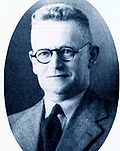History
The position of premier is not mentioned in the constitution of Western Australia. From 1890 to 1917, the premier was not an official position, rather, it was the title unofficially given, but widely used to refer, to the head of the government. [3] When Western Australia became a self-governing colony in 1890, Governor William Robinson initially indicated he would use the title prime minister to refer to the head of the government. However, after he appointed John Forrest, the title premier was used for consistency with the other Australian colonies. [3] The position was first officially mentioned when the governor appointed Henry Lefroy as premier on 28 June 1917. However, when the governor designated and declared the six executive offices of the government on 2 July 1917, the position of premier was not listed, creating an ambiguity. [3] [6] It was not until 3 April 1947 that the premier became one of the executive offices of the government. [3] [7]
The most common cause for a change of premier is an election. Since the 1990s, elections have occurred roughly every four years. Before then, elections were at most three years apart, except for during World War II. A less common cause for a change of premier is the ruling party changing its leader. This can occur as a result of a resignation, death or leadership spill. In this case, the new premier is whoever the party elects as its new leader. Another cause for a change of premier is a loss of majority support in the Legislative Assembly. This commonly occurred in the first three decades of self-governance, but has not occurred since 1916. If this occurs, the premier must either resign or be dismissed by the governor.
Powers and function
The powers of the premier are set out by convention and by legislation. By convention, the premier advises the Monarch of Australia as to who to appoint as governor. The premier advises the governor as to who to appoint to cabinet and which portfolios should be given to each cabinet minister. The premier sets out the responsibilities of ministers and the acts that they would administer. The premier leads the cabinet and chairs cabinet meetings. They communicate with the governor, the cabinet, the state government, other state and territory governments, the federal government, and overseas governments. The premier advises the governor on when state elections should be held. They oversee the Department of the Premier and Cabinet. While premier, they stay as a member of parliament and they retain their responsibility for representing their electoral district. [3]
Characteristics
As of 2023, there have been 31 premiers of Western Australia. [9] Carmen Lawrence, who was appointed on 12 February 1990, is the first and only woman to be premier of Western Australia. She is also the first woman to be premier of an Australian state. [3] [10] By convention, the premier is a member of the Legislative Assembly. However, the premier can be a member of either house of parliament. Hal Colebatch is the only premier to be a member of the Legislative Council (upper house). He served for 30 days in 1919, making him the shortest serving premier of Western Australia. [3] David Brand is the longest serving premier, serving for 11 years and 335 days between 1959 and 1971. [3] The youngest premier is John Scaddan, who was 35 years, 2 months and 3 days old when he was sworn in in 1911. [3] The oldest premier is John Tonkin, who was 69 years, 1 month and 1 day old when he was sworn in in 1971. [3] Newton Moore became premier after two years in parliament, the least time aside from Forrest. Tonkin became premier after almost 38 years in parliament, the most time in parliament before becoming premier. The only father and son pair to have both been premier is Charles Court and his son Richard Court. George Leake, who died of pneumonia on 24 June 1902, is the only premier to have died in office. [3] Moore, Philip Collier, John Willcock and Geoff Gallop are the only premiers to have resigned due to ill health. [16]
Forrest, Colebatch and Lawrence are the only premiers to have served in the Parliament of Australia as well. Forrest and Lawrence are the only premiers to have been ministers in the Government of Australia as well. Moore is the only premier to have served in the House of Commons of the United Kingdom. The only premier to subsequently serve as governor is James Mitchell. [3] George Leake, Frank Wilson, Phillip Collier and Mitchell are the only people to have been premier more than once. There are currently eight living former premiers. [19] The most recent premier to die is Ray O'Connor, who was premier from 1982 to 1983 and died in 2013. [20] [21]
Two former premiers have been sentenced to jail. In 1994, Brian Burke was sentenced to two years in jail for defrauding the state by $17,000 by making false claims on the parliamentary imprest account. [22] He was released on parole after serving seven months. [23] In 1995, O'Connor served six months in jail for stealing a $25,000 cheque from the Bond Corporation during his time as premier. [21] [24] In 1997, Burke was sentenced to three years jail for stealing $122,585 in Labor Party campaign donations. He served six months before this conviction was quashed upon appeal. [23] [25]
This page is based on this
Wikipedia article Text is available under the
CC BY-SA 4.0 license; additional terms may apply.
Images, videos and audio are available under their respective licenses.

































